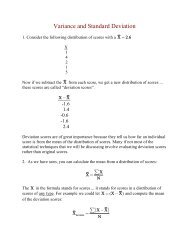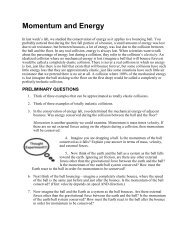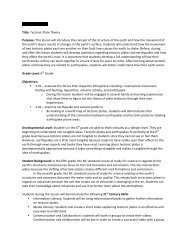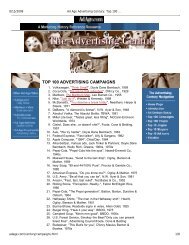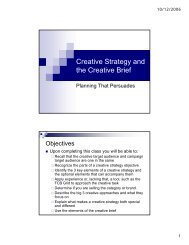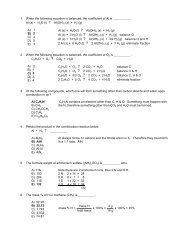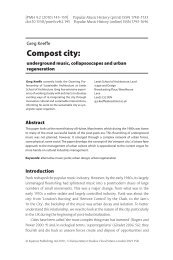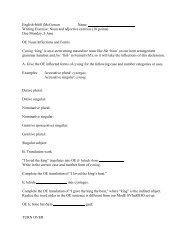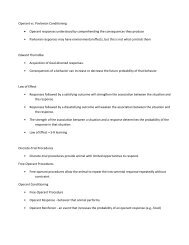Density
Density
Density
You also want an ePaper? Increase the reach of your titles
YUMPU automatically turns print PDFs into web optimized ePapers that Google loves.
<strong>Density</strong><br />
PART 1: FINDING DENSITY USING VOLUME<br />
<strong>Density</strong> is something that affects many of our everyday decisions. Conciously or not, we make<br />
mental calculations of density every time we interract with the physical world around us. Can we<br />
slide that box? Can we lift that rock? This lab examines some of the ways density effects our<br />
everyday lives.<br />
People are often confused about the difference between weight and density. There is an old<br />
riddle which highlights this confusion: “What weighs more – a pound of feathers or a pound of<br />
lead?” The answer, of course, is that both weight same – one pound. However, feathers are much<br />
less dense than lead, and therefore take up much more space. <strong>Density</strong> is the ratio of an object’s<br />
mass to its volume. This means that to find density, you must measure an object’s mass and<br />
divide it by the amount of space it takes up. The standard units of density are [kg/m 3 ], although<br />
other units are commonly used such as [g/ml], [g/cm 3 ], or [kg/l]. 1 ml has the same volume as 1<br />
cm 3 .<br />
PRELIMINARY QUESTIONS<br />
1. What two things do you need to know about a sample if you are to determine its density?<br />
2. What does density indicate?<br />
3. If you measured the density of a nail on the earth and then on the moon, would the<br />
densities vary? Why?<br />
4. If you measured the density of a gallon of water and then a teaspoon of water, would the<br />
densities vary? Why?<br />
5. Consider the concrete blocks below. A) Which has the greatest volume? B) The greatest<br />
density? C) the greatest mass?<br />
6. Consider the balloons below. These balloons were the same size, but the second one has<br />
gotten smaller due to a change in temperature. A) Which has the greatest volume? B) The<br />
greatest density? C) the greatest mass? Explain your answers.
MATERIALS<br />
Copper sample<br />
Graduated cylinder<br />
Triple beam balance with platform<br />
Stack of post-1982 pennies<br />
I. FINDING DENSITY USING VOLUME<br />
7. Design and describe an experiment that determines the density of water.<br />
8. Measure and record the mass of the copper sample.<br />
9. Determine the volume of the copper sample, first geometrically then by calculating the<br />
amount of water displaced in the graduated cylinder.<br />
10. Which method to you think is more accurate? Why?<br />
11. Using the method you feel is more accurate, determine the density of copper.<br />
12. Using the table below, compare the value you just calculated to the accepted values using<br />
percent error.<br />
Substance Aluminum Zinc Tin Iron Copper Silver Lead Gold<br />
<strong>Density</strong> [g/cm 3 ] 2.70 7.08 7.31 7.87 8.92 10.50 11.34 19.32<br />
II. FINDING DENSITY WITHOUT MEASURING THE VOLUME<br />
It is difficult to find the volume of an irregularly shaped object, e.g. an intricate golden crown.<br />
First of all, it is very difficult to determine the volume geometrically. Secondly, it is difficult to<br />
attain great precision by observing a change in water level. As observed in the density lab,<br />
volume is needed in order to determine the density of an object.<br />
ρ = m/V (1)<br />
If volume cannot be determined to any great accuracy, then how can one accurately determine<br />
the density of an object? Archimedes, according to legend, solved this problem while bathing.<br />
King Hieron had provided a quantity of pure gold to a smith to make into a crown. When the<br />
crown was complete, the king suspected the goldsmith of stealing some of the gold and<br />
substituting some other metal. The crown weighed the same as the original measure of gold, so<br />
Archimedes needed to know the density of the crown in order to determine whether there had<br />
been any foul play. He knew that the volume of the crown was equal to the amount of water it<br />
displaced, but needed a more precise method of measurement. While pondering this in the bath,<br />
Archimedes suddenly realized that he didn’t need to know the volume; only the weight of the<br />
water displaced. Since Archimedes was able to measure weight much more accurately than<br />
volume, this was very good news indeed!
Archimedes’ Principle: A body immersed in fluid is buoyed up by a force equal to the weight of<br />
the fluid displaced.<br />
F buoyant = W water dispaced (2)<br />
Since the immersion of an object in water results in some water being lifted, then that action<br />
would cause an equal and opposite force back on the object (see Newton’s 3 rd law). This is why<br />
an object in water seems to weigh less in water than out of the water. The observed difference in<br />
weight is equal to the weight of the water that the object displaces.<br />
W water displaced = (W object out – W object in ) (3)<br />
Now Archimedes could determine weight of the displaced water. He already knew the density of<br />
water (1.000 g/ml), and so he was now ready to calculate the volume of the displaced water, and<br />
then go on to calculate the density of the crown!<br />
13. How might Archimedes have determined the buoyant force (the difference in the weight<br />
of the crown in and out of the water)?<br />
14. How is the buoyant force related to the weight of the displaced water?<br />
15. If Archimedes knew the density of water and the weight of the displaced water, how<br />
could he then calculate the volume of the displace water?<br />
16. How is the volume of the displaced water related to the volume of the crown?<br />
17. If Archimedes knew the volume of the crown and the weight of the crown, how could he<br />
then calculate the density or the crown?<br />
18. As the tradition goes, Archimedes discovered that a quantity of silver had been mixed in<br />
with the gold, and so the goldsmith was exposed as a thief. What about his density results<br />
might have made Archimedes think that there could be some silver mixed in?<br />
19. Did Archimedes ever have to directly measure the volume of the crown or the volume of<br />
the displaced water?<br />
20. Given that the density of water is 1.000 g/ml, use Archimedes’ Principle to<br />
experimentally determine the density of the copper sample. Use the platform of the triple<br />
beam balance to support the cup while you measure the mass of the copper in and out of<br />
the water. When measuring the sample in the water, be sure that it is completely<br />
submerged and try to remove as many air bubbles as possible. Describe your experiment<br />
in detail and show all your work!<br />
21. Compare your value of the density of copper to the accepted value using percent error.<br />
22. Which method of determining density of copper gave you the better result?
III. WHAT ARE PENNIES REALLY MADE OF?<br />
Before the middle of 1982, pennies were made of solid copper. Beginning about halfway into the<br />
year 1982, pennies started being made of a less dense metal core with very thin copper plating.<br />
You will determine what post-1982 pennies are made of.<br />
23. Is it better to use a single penny and determine its density, or it is better to combine<br />
multiple pennies together to determine their density as a unit? Why?<br />
24. What is your method for determining the density of a penny? Describe in detail.<br />
25. Calculate the density of a post-1982. Show all your work!<br />
26. How will the small coating of copper on the outside of the mystery metal affect your<br />
measured density? How did you determine this?<br />
27. Compare your density calculation to the densities of the metals in the table above. What<br />
is your best estimate of the metal of the post-1982 pennies?



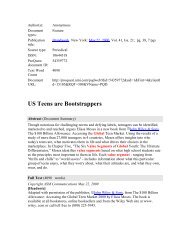

![Graduate Bulletin [PDF] - MFC home page - Appalachian State ...](https://img.yumpu.com/50706615/1/190x245/graduate-bulletin-pdf-mfc-home-page-appalachian-state-.jpg?quality=85)
